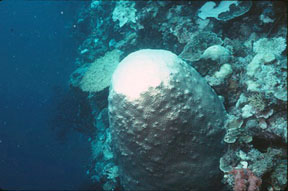 |
Office of Media Relations | |||
News | ||||
|
Coral Reef Resilience: Better Feeders Survive Bleaching
Global warming and other threats are killing coral reefs through a phenomenon known as bleaching. But why do some corals survive? A new study, published in Nature, is the first to document a trait that helps some coral species live through, and recover from, bleaching. The survivors’ secret: Ramped up feeding rates. PROVIDENCE, R.I. — Coral bleaching, a stress response that turns rainbow-hued reefs into bone-white graveyards, is damaging reefs worldwide. But some corals survive. A Nature report identifies a new trait critical to coral resiliency – the ability to kick feeding rates into overdrive.  Eating as the key to health In an experiment with three species of Hawaiian corals researchers found that, when bleached, the branching coral Montipora capitata sharply increased its intake of tiny plankton, making it much more likely to bounce back. The findings suggest that any coral, regardless of shape or location, may recover from bleaching if it can ramp up feeding. James Palardy, a Brown University graduate student and co-author of the Nature paper, said the results indicate that these corals may become the dominant species in reefs and could play a role in protecting these critical marine ecosystems. “These ‘super-feeders’ have an ecological advantage, one that may protect reefs from extinction,” Palardy said. “If our results hold up with other species, we may well see that these resilient corals are the future for our reefs.” Coral reefs reduce beach erosion, support tourism and serve as breeding grounds and habitat for fish. A 2006 report by the United Nations Environment Programme put the value of coral reefs at $100,000 to $600,000 per square kilometer per year. But the UNEP report states that 30 percent of the world’s coral reefs are severely damaged or dead and that 60 percent of remaining reefs will vanish by 2030. Several factors are to blame, from pollution to overfishing. Scientists say the biggest new threat is global warming. Because corals are highly sensitive to temperature, even small amounts of warming can trigger bleaching. When water temperatures rise, coral expel single-celled algae called zooxanthellae, which live inside coral tissue and give corals their color and, more importantly, supply the bulk of their food energy. If bleaching persists, corals die, leaving behind ghostly limestone skeletons. Some corals can survive bleaching. The reasons for this, however, aren’t well understood. Palardy and his colleagues had a hunch: In the absence of algae-derived nutrition, corals may tap energy reserves or increase feeding, a process where corals use their tiny tentacles to “grab” passing plankton and stuff them into their stomachs. To study the role metabolism and feeding might play in coral resiliency, Palardy, a Brown Ph.D. student in the Department of Ecology and Evolutionary Biology, collaborated with Andréa Grottoli, an assistant professor of geological sciences at Ohio State University, and Lisa Rodrigues, a post-doctoral research fellow in biology at Villanova University. The team took chunks of three types of healthy Hawaiian corals – M. capitata, another branching coral called Porites compressa and the mounding coral Porites lobata – from colonies off the coast of Oahu and put them in eight outdoor tanks. Water in four of the tanks was kept at 27° C, the typical reef water temperature. In the other four, water temperature was elevated to 30° C, warm enough to trigger bleaching. After 30 days in the tanks, the team measured chlorophyll concentrations, photosynthetic rates, and lipid levels in some corals. The remaining corals were returned to the reef to recover. After two weeks on the reef, researchers covered some of the healthy and bleached corals with fine mesh boxes, which kept plankton out of reach. The boxes went over the corals eight hours a day, then removed for an hour each night for five days. The goal: Empty their stomachs, so that the plankton the corals consumed could be accurately measured. Researchers dissected the corals and painstakingly counted plankton in their stomachs. Researchers also created a system of measurements that gauged the corals’ energy input from feeding. Four weeks later, the scientists weighed the remaining corals and again measured chlorophyll concentrations, photosynthetic rates and lipid levels. The results: P. compressa and P. lobata depleted their energy reserves during bleaching. And when these bleached and unbleached corals were compared, feeding didn’t increase. In contrast, the feeding rates of bleached M. capitata increased five-fold, allowing them to replenish their energy reserves – making it more likely that they’ll survive and spawn after a bleaching event. “The results were a surprise,” Palardy said. “Previous studies showed that thick tissue layers or mounded shapes made corals resilient. But we found a new resiliency factor – feeding. In evolutionary terms, corals that eat more may win.” The National Science Foundation, the Mellon Foundation, and a William Penn Fellowship funded the work. ###### Media Relations Home | Top of File | e-Subscribe | Brown Home Page | ||||